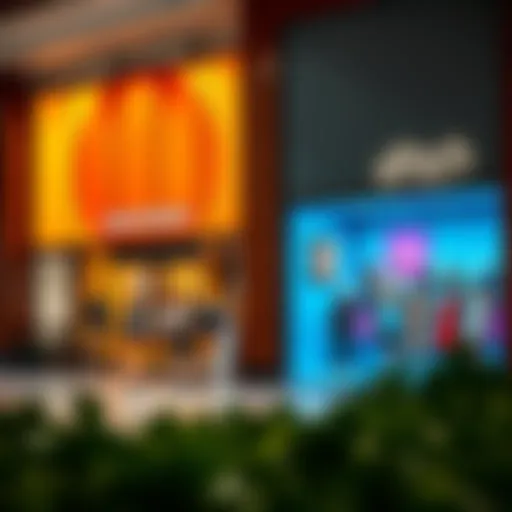Exploring Al Shindagha: Dubai's Cultural Heritage
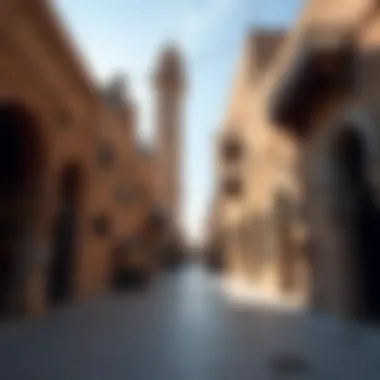

Intro
Exploring Al Shindagha feels like stepping onto the pages of a living history book, where each corner and alley tells a story of Dubai’s rich past. Nestled along the banks of Dubai Creek, this historic neighborhood serves not just as a reminder of bygone days but as a vibrant link to the city's rapid urban evolution. Walking through its winding streets, you might feel the whispers of the traders who once roamed these paths, bartering spices and textiles—a nod to Dubai's origins as a trading hub.
Not far from the glitzy skyscrapers that define modern Dubai, Al Shindagha offers a unique juxtaposition. Here, the narrow lanes host traditional homes, ornate wind towers, and cultural centers that preserve the Emirate’s customs and architectural styles. Rather than being lost amidst the rapid modernization sweeping the city, Al Shindagha is undergoing a renaissance, blurring the line between the past and present.
From its historical significance to ongoing developments, this article shines a light on what makes Al Shindagha a critical piece of Dubai's identity.
Market Overview
Current Trends
In recent years, Al Shindagha has emerged as a focal point for cultural tourism, largely due to the revitalization efforts spearheaded by Dubai's visionaries. The market trends here reflect an increasing demand for properties that fuse traditional charm with modern conveniences. Investors are keen to explore opportunities within the neighborhood, recognizing its allure as both a tourist destination and a residential area.
Attributes such as proximity to key attractions like the Dubai Museum and the heritage village create a magnetic pull. Notably, the neighborhood is also witnessing a rise in boutique hotels and restaurants that offer visitors a taste of the local culture while promoting sustainability—an aspect increasingly valued in today’s market.
Forecast and Predictions
As Dubai continues to position itself as a global crossroads, Al Shindagha is poised for growth. Experts suggest that the area will see an influx of investment, with property prices expected to appreciate steadily as revitalization initiatives unfold. The community's plan to enhance infrastructure, including improved transport links and pedestrian-friendly areas, will further attract both locals and expatriates.
To sum up, the forecast for Al Shindagha heads upward, fueled by cultural significance and strategic development initiatives.
"Al Shindagha is more than just a historical site; it's a vision for Dubai's future, interweaving past legacies with the aspirations of a modern city."
Investment Opportunities
Residential Properties
For homebuyers and investors alike, Al Shindagha presents a myriad of residential options. From beautifully restored heritage homes to modern apartments, there's something to cater to diverse tastes. Many properties retain their original architectural allure while incorporating contemporary features, making them highly desirable. Locations near the creek are particularly appealing due to their scenic views and serenity, offering a unique living experience.
Commercial Ventures
On the commercial front, Al Shindagha stands out as a promising location for retailers and entrepreneurs. The neighborhood is increasingly attracting small businesses—especially cafes, art galleries, and boutique shops—that complement the cultural vibe. With foot traffic rising due to tourist interest, establishing a business in this area could yield significant returns.
Further Reading:
Preamble to Al Shindagha
Al Shindagha represents not just a location but a symbol of the intricate history that shapes Dubai. This historic neighborhood is a microcosm of the emirate’s journey, reflecting its past, present, and future. Understanding Al Shindagha provides insight into the cultural and architectural identity of Dubai. It offers a chance to experience a rich tapestry woven from the old and new, showcasing how historical elements coexist with modern vibrancy.
The importance of this neighborhood lies in its ability to serve as a living museum. Wandering through its narrow alleyways feels like stepping back in time, yet the area is also firmly entrenched in today’s urban framework. Here, traditional markets rub shoulders with contemporary developments, creating a space where the heritage still breathes amid rapid change.
Geographical Context
Al Shindagha is nestled along the Dubai Creek, famously acting as the gateway to the city and connecting it with its maritime heritage. The creek, snaking its way through the landscape, has historically been the lifeblood of trade and commerce, feeding the thriving economy of Dubai. The area's strategic position near significant land routes made it a central hub where merchants gathered. This natural harbor played a vital role in establishing Dubai as a crucial maritime hub in the Gulf.
Not merely a geographical marker, the creek influences the neighborhood's climate, promoting a warm maritime atmosphere dotted with cool breezes that can be felt from the waterfront. Al Shindagha combines the bustling energy of city life with the soothing presence of water, making it a unique geographical entity that fosters a connection to its surroundings.
Historical Overview
The historical narrative of Al Shindagha is rich and compelling. It dates back to the 19th century when the area began to emerge as a significant center for trade. This was a time when pearl diving, fishing, and trade with distant lands began to flourish. The traditional wind-tower architecture found here tells the story of how ancient techniques were ingeniously designed to keep living spaces cool, illustrating the adaptability of early settlers to their environment.
Throughout the years, the neighborhood has witnessed substantial changes due to socio-political shifts and global events. The discovery of oil in the mid-20th century marked a turning point in Dubai's trajectory, leading to rapid development and modernization. Despite the swift advances in urbanization, Al Shindagha has managed to retain its historical significance, with many heritage sites still drawing visitors and scholars alike.
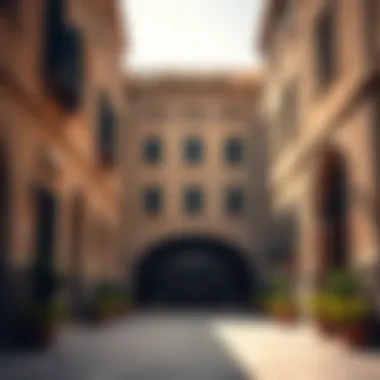

To sum up, Al Shindagha is much more than a collection of historical buildings. It is a testament to Dubai's evolution and a reminder of the city’s roots. Understanding the geographical and historical context of this neighborhood yields profound insights into the emirate's identity today and lays the groundwork for appreciating its future developments.
Cultural Significance of Al Shindagha
Al Shindagha is more than just a neighborhood in Dubai; it's a vibrant tapestry woven from the threads of history, tradition, and living culture. The cultural significance of this area lies in how it embodies the identity of the emirate, reflecting centuries of interaction between different peoples and customs. As Dubai rapidly modernizes, understanding the essence of Al Shindagha allows us to glimpse into the emirate's past while maintaining a connection to its roots.
Heritage and Identity
At the core of Al Shindagha's significance is its deep-rooted heritage. Once the heart of Dubai, this area houses many important historical sites, such as the Dubai Museum, which was formerly a fort and illustrates the life of Emiratis before the oil boom. This heritage serves not only to educate visitors about Dubai's storied past but also to foster a sense of belonging among local residents. By preserving traditional buildings, like the wind-tower houses, Al Shindagha stands as a monument to the architectural ingenuity of the past.
Moreover, heritage extends beyond architecture. The bustling markets, or souks, where traders once peddled spices and textiles, still thrive today. These markets are meeting points of culture and commerce, allowing the community to uphold age-old customs while adapting to new ones.
"Al Shindagha is a living museum, where every corner echoes the stories of the past, preserving the identity of a people."
Traditions and Practices
The traditions within Al Shindagha showcase a rich cultural mosaic. One of the most important aspects is the annual celebrations that honor Emirati customs. Events such as the UAE National Day and Eid celebrations are held with great fervor. You can see colorful parades, traditional dance performances, and culinary showcases highlighting dishes like mahshi and luqaimat. These festivities create a blend of old and new, drawing both residents and visitors into a shared experience of joy and unity.
Beyond festivals, local practices such as falconry and dhow sailing take center stage here. Falconry is not only a sport but an expression of cultural pride and connection to the desert. The ships, or dhows, that once facilitated trade across the seas continue to be a symbol of maritime heritage, reminding everyone of the historical significance of trade in shaping Dubai's economy and culture.
As we examine the cultural significance of Al Shindagha, it's clear that this neighborhood is a crucible where past and present reside in harmony. The ongoing commitment to preserving cultural practices and heritage ensures that future generations will have a tangible connection to what makes Dubai unique. It’s not just about retaining a history; rather, it's an active engagement with culture, allowing individuals to shape and share their own identity.
Architectural Characteristics
The architectural landscape of Al Shindagha holds a mirror to Dubai's intrinsic identity. Nestled alongside the sparkling waters of the Dubai Creek, this neighborhood encapsulates the artistic expressions of its past while deftly embracing modernity. The structures within Al Shindagha tell stories of resilience and adaptation, reflecting both historical richness and current aspirations. Understanding the architectural characteristics of this neighborhood is essential for anyone looking to delve deeper into its cultural and economic significance.
Traditional Structures
Al Shindagha's traditional structures offer a glimpse into the heritage of Emirati architecture. The buildings, often constructed from coral and gypsum, exhibit intricate designs that are not merely functional but also aesthetically pleasing. For instance, the Wind Towers—a hallmark of traditional Arabian architecture—are strategically designed to capture winds, providing a natural form of air conditioning before the advent of modern technology.
The neighborhood’s layout reflects a community-centric design, with narrow alleyways promoting social interaction among residents. This thoughtful urban planning not only enhanced the neighborhood's livability but also fostered a sense of identity rooted in its historical context.
Moreover, the House of Sheikh Saeed Al Maktoum, a prime example of traditional architecture, stands as a testament to the ingenuity and craftsmanship of the era. With its wooden beams, decorative motifs, and spacious courtyards, it serves as a cultural hub, drawing visitors and residents alike to experience the rich tapestry of Emirati life.
Modern Developments
Transitioning into contemporary designs, Al Shindagha showcases a blend of old-world charm and cutting-edge innovation. Recent developments are characterized by sleek lines and reflective glass facades that contrast starkly with the age-old structures, generating an intriguing conversation between the two eras.
Buildings like the Dubai Opera House—while not technically in Al Shindagha—often influence the architectural discourse of the area. The modern developments seek to integrate the heritage with sustainable practices, such as using locally sourced materials and incorporating energy-efficient technologies. This approach not only brings a fresh vibe but serves an essential educational purpose on sustainability in urban planning.
Al Shindagha’s transformation captures the spirit of a city that embraces future-forward thinking while remaining respectful of its past.
Public Spaces and Infrastructure
Public spaces in Al Shindagha have a distinctive charm, intertwining nature with urban life. The Dubai Water Canal, a recent addition to the area, has become a focal point, promoting recreational activities and waterfront enjoyment. With walking and cycling paths incorporated into its design, the canal has redefined how residents and visitors engage with the neighborhood.
In addition to the canal, the community has prioritized green spaces, creating parks that serve as both recreational areas and spaces for communal activities. These parks facilitate cultural exchanges and allow for a tapestry of events, enhancing social cohesion.
Infrastructure developments, including improved public transport routes like the Dubai Metro, have augmented accessibility. This interconnectedness signifies not just a transit improvement but a commitment to making Al Shindagha a vibrant, integrated part of Dubai’s urban landscape.
The evolution of Al Shindagha's architectural characteristics illustrates a ceaseless dialogue between its deep-rooted history and the pulsating rhythm of modern urban life. Such dynamics are crucial for investors and homebuyers who seek more than just property; they are looking to invest in an evolving narrative.
Economic Transformation
The economic transformation of Al Shindagha paints a vivid picture of how this historic neighborhood has evolved in response to the tides of globalization and urban development. Understanding how this area has been reshaped is crucial for anyone interested in the intricate blend of past and present, especially investors, homebuyers, and urban planners.
With its strategic location near the Dubai Creek, Al Shindagha has always been a vital hub for trade and commerce. This positioning has led to a significant rise in tourism and real estate, creating ripple effects across various sectors.
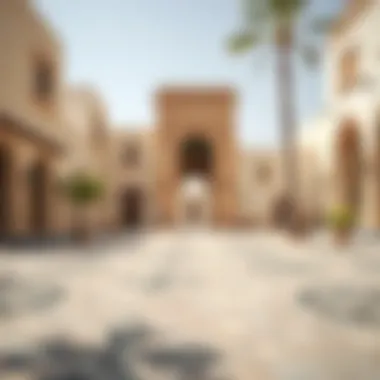

Impact of Tourism
Tourism has been a game changer in the economy of Al Shindagha. In recent years, the neighborhood has attracted a diverse crowd, drawn by its rich heritage, traditional souks, and cultural landmarks like the Sheikh Saeed Al Maktoum House. This influx has generated substantial revenue, making Al Shindagha a focal point for cultural tourism in Dubai.
Notably, tourism in this area is not merely about attracting visitors; it's tied deeply to economic opportunities for local residents. The small businesses, craft shops, and eateries thriving in the neighborhood benefit considerably from the footfall. For instance:
- Local Craftsmanship: Artisans producing traditional items such as textiles and jewelry have found a ready market among tourists eager for authentic souvenirs.
- Culinary Tourism: The neighborhood’s eateries, serving dishes rooted in Emirati culture, have become popular dining spots, enhancing the local economy.
Moreover, with ongoing initiatives to enhance visitor experiences, the economic benefits are expected to burgeon further.
Real Estate Development
Real estate development within Al Shindagha reflects a thoughtful balance between preserving historical integrity and accommodating modern needs. In this era of rapid growth, developers are recognizing the value of heritage sites, which provide both charm and investment potential.
Recent projects have focused on:
- Mixed-Use Developments: Developers are prioritizing projects that integrate residential, commercial, and leisure spaces, thereby creating vibrant urban environments. This approach caters to the lifestyle of residents and visitors alike, offering convenience and enhancing community interaction.
- Restoration of Heritage Sites: Investment in restoring traditional structures not only helps preserve the neighborhood’s cultural legacy but also attracts tourists and residents who appreciate historical authenticity.
This careful planning has been instrumental in elevating property values. Investors are shown to favor areas steeped in culture, and Al Shindagha certainly fits the bill. However, it’s worth considering that while the area enjoys a favorable market, it requires a balanced strategy to ensure sustainable development.
In summary, the economic transformation of Al Shindagha is a microcosm of Dubai’s broader development narrative. As tourism flourishes and real estate adapts in thoughtfully integrated ways, this neighborhood illustrates a successful model of how history can inform and enrich modern urban landscapes.
"Al Shindagha exemplifies the harmony between history and modernity, revealing that economic growth does not have to come at the expense of cultural heritage."
For more insights into the ongoing transformations in Dubai, you can explore resources such as Dubai Tourism, or investigative pieces on cultural preservation.
Al Shindagha in Contemporary Dubai
Al Shindagha, once a quiet coastal neighborhood, now stands as a significant contributor to Dubai's urban landscape amidst rapid development. The area's historical essence is being thoughtfully integrated into modern contexts, rendering it a vital piece of the larger narrative of how tradition can coexist with contemporary aspirations. The story of Al Shindagha reflects not only the growth of Dubai but also a commitment to preserving cultural identifiers amidst economic endeavors.
Revitalization Efforts
In recent years, a concerted effort has been made to revitalize Al Shindagha while retaining its historic charm. Investments have flowed into infrastructure improvements, aiming to enhance connectivity with other parts of Dubai. New walkways and restored buildings are reminiscent of the area’s original architecture, inviting both tourists and locals to roam freely. Key steps taken in this transformation include:
- Restoration Projects: Several historical buildings have undergone restoration, reviving traditional styles while incorporating modern techniques that ensure durability and safety.
- Cultural Events: Local authorities have increased the frequency of cultural events and festivals, celebrating the rich heritage of the neighborhood and fostering a sense of community.
“The past should inform the future; it’s not about erasing history but weaving it into the present,” asserts a local historian reflecting on these changes.
This revival is of utmost importance as it provides a tangible link to Dubai's rich past, serving as an educational platform for generations to come.
Integration of Modern Amenities
The integration of modern amenities into Al Shindagha has been carefully executed to complement the area’s historical attributes. While new developments like cafes, art galleries, and boutiques dot the landscape, they have been designed with a respect for the surroundings. Notable integration efforts include:
- Smart Technology: Implementing smart city technology improves the urban experience with features like free Wi-Fi in public areas and smart lighting. Travelers can navigate the neighborhood with ease, enhancing their exploration of the cultural hotspots.
- Public Transportation: Enhanced public transit options connect Al Shindagha to major Dubai hubs, encouraging visitors and residents to explore the neighborhood frequently.
- Tourist Information Centers: New centers have been established to provide cultural context to visitors, ensuring they appreciate the intricacies of Al Shindagha while enjoying its modern quirks.
The commitment to marry modernity with tradition rings loudly in Al Shindagha. This approach not only promotes tourism but ensures that the cultural narrative is preserved for future generations. As the area continues to embrace transformation, it paves the way for urban development that respects the tapestry of its history while catering to contemporary needs.
The ongoing efforts in Al Shindagha exemplify how a historical neighborhood can adapt to modernity without losing sight of its roots—offering a blueprint for other historic sites in Dubai to follow.
Community Insights
The neighborhood of Al Shindagha stands as a testament to the evolving patterns of community life in Dubai. This section explores the perspective of the local residents and highlights the remarkable cultural exchange and diversity that have come to define this historic area. The essence of community insights is rooted in understanding the fabric of daily life, the interactions within the neighborhood, and the shared experiences that bind its residents together.
Local Residents' Perspectives
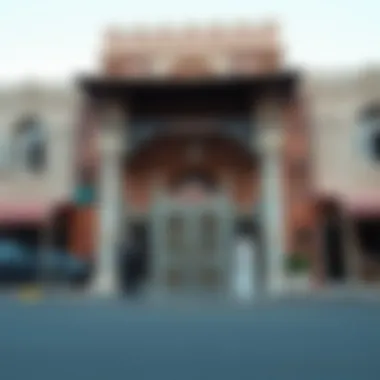

The voices of local residents offer invaluable insights into the character of Al Shindagha. For many, the neighborhood is more than just a place to live; it's a canvas reflecting their history, traditions, and aspirations. Residents express a deep connection to the area, often recounting tales of family lineage stretching back to the early days of Dubai's development. They talk about the significance of the winding alleyways, the bustling souks, and the serene waterfront that provide a unique backdrop for their daily lives.
In discussions with residents, common themes emerge:
- A Sense of Belonging: Many articulate a strong sense of belonging. It fosters social relationships and brings solace amidst the rapid modernization surrounding them.
- Cultural Heritage: Residents emphasize the importance of preserving cultural practices, sharing traditional recipes, and celebrating festivals that honor their ancestry.
- Community Engagement: There are various local initiatives aimed at strengthening ties among residents. Workshops, art exhibitions, and cultural programs often bring together people from diverse backgrounds, enhancing community cohesion.
"To us, Al Shindagha is not just a neighborhood; it's our home and our identity. We honor our past while embracing the future together."
The local perspectives on Al Shindagha help paint a rich picture of how residents navigate life in this vibrant area. Their stories reflect a juxtaposition of nostalgia and optimism, resonating deeply with anyone interested in the dynamics of urban living.
Cultural Exchange and Diversity
Al Shindagha serves as a melting pot where cultures converge and coalesce, making cultural exchange and diversity one of its standout features. This area has historically attracted traders, artisans, and expatriates from various parts of the world, leading to a vibrant tapestry of cultural influences. The intertwining of traditions often finds expression in local festivals, markets, and art.
Key aspects of cultural exchange in Al Shindagha include:
- Multicultural Events: Festivals celebrating the diversity of the resident population occur throughout the year. From art shows to food festivals, residents and visitors alike revel in a range of cultural experiences.
- Food Diversity: The culinary scene in Al Shindagha reflects its diverse population, with eateries offering everything from traditional Emirati dishes to Indian, Pakistani, and Filipino cuisines. This not only satisfies local palates but also encourages culinary creativity and innovation.
- Artistic Collaboration: Local artists often collaborate on community projects, creating murals and sculptures that reflect the rich history and vibrant character of Al Shindagha, thus preserving traditions for future generations.
As globalization continues to shape urban landscapes, Al Shindagha stands out in successfully managing its cultural diversity. It serves not just as a backdrop for the convergence of cultures, but also as a vibrant entity that fosters mutual understanding and respect.
Through examining community insights, this area reveals its narrative as a unique and dynamic space, showcasing the resilience and adaptability of its residents. The blend of historical and contemporary influences creates a thriving community that epitomizes the true spirit of Dubai.
Future Prospects of Al Shindagha
As urban areas evolve, it's crucial to anticipate the future trajectories of neighborhoods like Al Shindagha. With its deep-rooted history and cultural significance, understanding the future prospects of this area becomes not just an academic exercise but a vital consideration for developers, policymakers, and community advocates alike. These prospects hinge on both urban planning initiatives and sustainability goals that aim to integrate Al Shindagha's rich tapestry of tradition with modernity.
Urban Planning Initiatives
Urban planning in Al Shindagha serves as a pivotal element in shaping its future. Recent focus has been directed toward improving infrastructure while maintaining the area's historical essence. The Dubai authorities have embarked on various projects that emphasize pedestrian-friendly pathways, improved public transport options, and enhanced green spaces.
- Proximity to Key Areas: One of the focal points in these initiatives is ensuring that Al Shindagha maintains accessibility to prominent locations such as the Dubai Creek and downtown Dubai. This access is paramount for tourists and residents alike, bolstering both economic activity and cultural exchange.
- Zoning Regulations: Implementing adaptive zoning regulations is another aspect. These regulations encourage mixed-use developments where cultural establishments—like museums and art galleries—can thrive alongside residential spaces. By creating a mixed-use environment, planners envision a livelier neighborhood that keeps both locals and visitors engaged.
"Urban planning isn’t just about bricks and mortar; it’s about creating a community."
Another commendable strategy involves the revitalization of heritage sites within Al Shindagha. Renovation efforts for buildings such as the Sheikh Saeed Al Maktoum House are indicative of how urban planning can marry preservation with modern needs, ensuring that history isn’t just tucked away but showcased in a vibrant urban fabric.
Sustainability Goals
In the realm of sustainability, Al Shindagha stands at a crucial crossroads. The push for eco-friendly practices in urban living is more than a trend; it’s becoming a necessity. The future envisioning of Al Shindagha incorporates sustainable practices that respect both its cultural significance and the environmental imperatives of today.
- Green Spaces: Plans to enhance greenery throughout the neighborhood are already underway. Parks and community gardens not only beautify the area but also promote biodiversity. This initiative encourages social gatherings, which help enhance community ties.
- Energy Efficiency: Implementation of energy-efficient infrastructure is on the rise. Buildings are increasingly designed to utilize renewable energy sources, reducing the carbon footprint of the neighborhood. The district's energy systems are being refined to align with the broader UAE goals for sustainability, making them models for other regions.
In summary, the future of Al Shindagha hinges on strategic urban planning and a commitment to sustainability. By marrying modern living with time-honored traditions, this historic neighborhood not only prepares for growth but also cherishes its identity in a rapidly changing urban landscape. As investments flow into the area, the careful management of its development is essential for preserving the very essence that makes Al Shindagha a cornerstone of Dubai's rich historical narrative.
Epilogue
When we step back and look at Al Shindagha, we see more than just a neighborhood; we see a living museum, rich with stories and layered histories intertwined with the very fabric of modern Dubai. The importance of reflecting on preservation here extends beyond mere nostalgia—it signifies a commitment to safeguarding the cultural identity that distinguishes this area amidst the waves of change.
Reflections on Preservation
Preservation efforts in Al Shindagha allow us to honor the past while making room for a vibrant future. It’s not just about keeping ancient buildings standing; it’s about fostering a sense of community and continuity. From the traditional wind towers that once cooled homes in the blistering sun to bustling souks filled with the aroma of spices, every element is vital for understanding the heritage of the Emirate.
Investing in the preservation of Al Shindagha pays dividends in multiple ways. It nurtures tourism, creating a bridge to local culture for visitors keen on experiencing authentic Emirati life. Additionally, it helps educate younger generations about their roots. When local schools emphasize the importance of cultural heritage, they instill pride and awareness in children who will be tomorrow's leaders.
The Role of Al Shindagha in Dubai's Narrative
Al Shindagha stands not just as a geographical location but as a crucial chapter in Dubai's ever-evolving narrative. This area is a testament to how urban spaces can retain their essence even while adapting to modern contexts. Al Shindagha embodies the fusion of ancient practices with contemporary lifestyles. It showcases how economic growth doesn’t have to come at the expense of cultural erosion.
Al Shindagha serves to remind us that even in a city known for its skyscrapers and cutting-edge technology, there exists a profound respect and appreciation for the past. As new developments sprout around the neighborhood, they can serve to enhance rather than overshadow its historical significance. By weaving Al Shindagha’s rich past into the modern tapestry of this global city, Dubai can foster a unique identity that intertwines tradition with innovation.
This synthesis of old and new plays a central role in Dubai's broader narrative, shaping local policies and influencing community engagement. Understanding Al Shindagha can provide investors and stakeholders with insights into the heart of Dubai, offering a look at how historical context can guide future endeavors.
As we wrap our exploration, it becomes evident that Al Shindagha is more than a historical neighborhood; it’s a symbol of perseverance and adaptability. Those who wish to invest in this rich terrain are not just buying property; they’re contributing to a living legacy.

